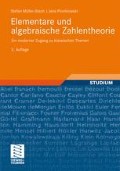Zusammenfassung
Im ersten Abschnitt haben wir die Primzahlen als natürliche Zahlen ungleich 1 definiert, die nur 1 und sich selbst als Teiler haben. Dies kann man so verstehen, dass die Primzahlen unzerlegbar sind:Wenn man eine Primzahl p in ein Produkt zweier natürlicher Zahlen zerlegt, ist die eine davon p und die andere 1. Zum Beispiel kann man 13 nur zerlegen als 13=13• 1, 6 jedoch als 6= 6• 1=2 3. Jeder kennt auch noch eine weitere Charakterisierung einer Primzahl p : Falls p das Produkt zweier natürlicher Zahlen teilt, dann teilt p bereits eine dieser Zahlen. Zum Beispiel teilt 13 das Produkt 39• 21 und damit (hier) den ersten Faktor 39= 3• 13, aber obwohl 6 das Produkt 4• 9 teilt, teilt sie weder 4 noch 9.
Access this chapter
Tax calculation will be finalised at checkout
Purchases are for personal use only
Preview
Unable to display preview. Download preview PDF.
Author information
Authors and Affiliations
Rights and permissions
Copyright information
© 2011 Vieweg+Teubner Verlag | Springer Fachmedien Wiesbaden GmbH
About this chapter
Cite this chapter
Müller-Stach, S., Piontkowski, J. (2011). Teilbarkeitstheorie. In: Elementare und algebraische Zahlentheorie. Vieweg+Teubner. https://doi.org/10.1007/978-3-8348-8263-9_2
Download citation
DOI: https://doi.org/10.1007/978-3-8348-8263-9_2
Publisher Name: Vieweg+Teubner
Print ISBN: 978-3-8348-1256-8
Online ISBN: 978-3-8348-8263-9
eBook Packages: Life Science and Basic Disciplines (German Language)

